Zucchini, a popular summer squash also widely called a Courgette, is a versatile and delicious vegetable and a joy to cultivate in home gardens.
With a mild, slightly sweet flavor and firm texture, it is also characterized by its soft edible seeds.
To successfully grow healthy zucchini plants, it’s essential to understand the various growth stages of zucchini during its life cycle.
From germination to harvesting mature fruits, each phase of growing zucchini holds its own significance and requirements.
This article will explore the different growth stages of zucchini plant, providing insights into the plant’s development and offering valuable tips to growing zucchini and maximizing your fruit production.
Read on till the end to learn how to harvest a good zucchini stock!
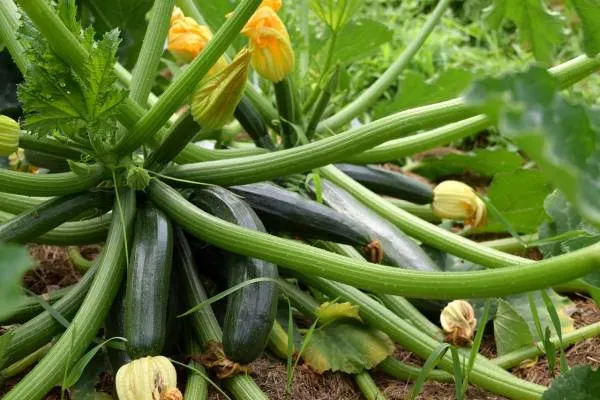
Growth Stages of Zucchini Plants | Analyzing 8 Zucchini Growth Stages!
All growth stages of zucchini have their own requirements and role to play in the whole process, after which you see a lush dark green fruit ready to get devoured.
Following are the 8 growth stages of zucchini plants.
Stage 1: Planting Zucchini Seeds
Planting the seeds marks the beginning of the zucchini growth stages.
Here’s a breakdown of the steps involved in this initial stage to plant zucchini:
Seed Selection: Choose zucchini seeds that are fresh, viable, and suited to your growing region.
Timing: Wait until the danger of frost has passed and the soil temperature reaches around 60°F (15°C). Zucchini plants thrive in warm weather, so planting in late spring or early summer is ideal.
Soil Preparation: Loosen the soil to a depth of about 8 to 12 inches (20 to 30 cm) to facilitate root growth. Incorporate organic matter to improve soil fertility and drainage.
Spacing: Zucchini plants require adequate space to grow and spread. Leave about 2 feet between each zucchini plant to ensure proper air circulation and minimize nutrient competition.
Planting: You can start zucchini seeds indoors. Dig small holes or trenches in the prepared soil. Place 2 to 3 seeds in each hole at the depth according to the package instructions.
Watering: After you have planted the seeds, keep the soil moist to ensure good seed-to-soil contact and provide moisture for germination. Also, keep well drained soil and don’t overwater, as it can cause rotting.
Now, let’s take a look at the following zucchini plant growth stages.
Stage 2: Germination Zucchini Seeds
Within 7 to 10 days, the zucchini seeds should begin germinating, as they are not fragile and grow fairly quickly. The minimum temperature suitable for the zucchini plant is 60 degrees Fahrenheit, but 70–95 degrees Fahrenheit is also ideal.
Zucchini seeds are typically sown directly in well-prepared soil when the threat of frost has passed. The germination process begins as the seeds absorb moisture from the soil. The seeds will sprout within a week or two, and tiny zucchini seedlings will emerge.
Stage 3: Seedling Growth Stage
The two special tiny leaves that shoot out of the seeds are commonly known as cotyledons.
They play a vital role in growing season supporting the seeds as they are able to perform photosynthesis and are present throughout the process of germination. Then 10–14 days later, they will be replaced by true leaves.
At this stage, their first set of true leaves will look different from the initial seed leaves. Seedlings will require ample sunlight, preferably six to eight hours per day, and regular watering to establish strong root systems.
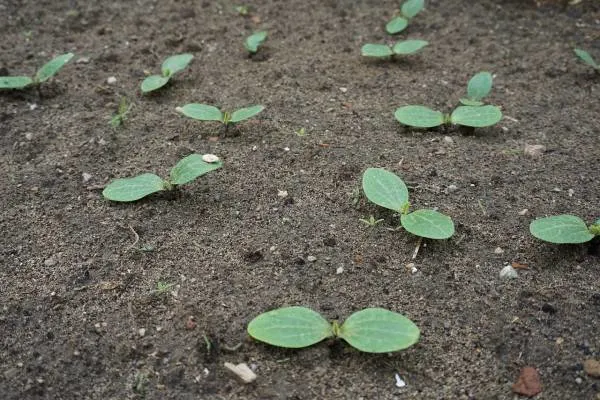
Stage 4: Vegetative Growth
During the vegetative stage, zucchini plants focus on leaf and stem development.
Lush foliage begins to spread, and zucchini growth accelerates as it soon needs to produce flowers and fruit. This usually happens within the first forty-five days, and Bush varieties can grow and rise to 2 meters in length while vines can reach approximately 6 feet.
Regular watering, preferably at the base of the plant to prevent water splashing on the leaves, is essential. Adequate spacing between plants and regular weeding will help minimize competition and ensure optimal growth.
In addition, fertilize zucchini during the growing season. Use a fertilizer with low nitrogen content, as it will prevent unnecessary vegetative development and decreased fruit production.
Related Article: Why Are My Zucchini Leaves Turning Yellow – 5 Causes (growgardener.com)
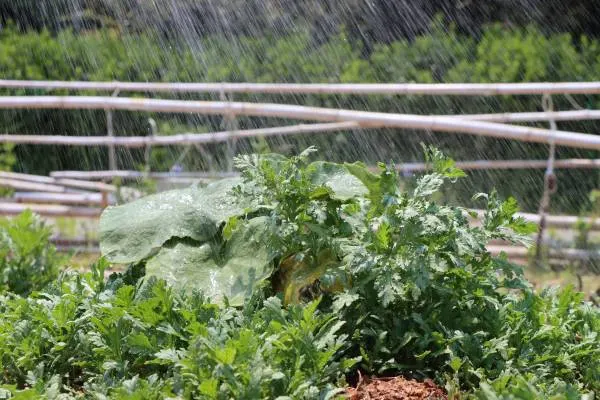
Stage 5: Flowering Stage
Zucchini plants mature after approximately 6 weeks and enter the flowering stage.
At the plant’s center head, bright yellow, vibrant, large zucchini flowers begin to appear, attracting pollinators like bees.
Zucchini plants produce separate male and female flowers. Male flowers bloom first, followed by female zucchini flowers after a few days.
Bees play a crucial role in pollination, transferring pollen from the male flowers to female flowers. To encourage successful pollination, avoid using pesticides that may harm bees and other beneficial insects.
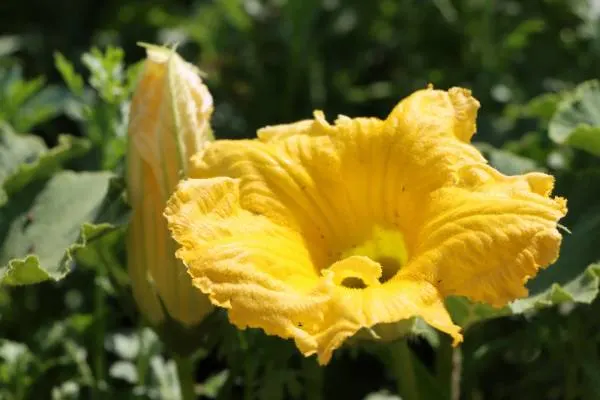
Stage 6: Pollination Stage
The pollination stage is vital for successful zucchini fruit development.
Male flowers and female flowers emerge on the same plant, and bees play a crucial role in transferring pollen from the male flower to the female flowers.
Creating a pollinator-friendly environment, avoiding pesticides, and planting companion flowers attract bees. Hand pollination can be done if pollinators are scarce.
Zucchini flowers are receptive for a short period, so timing is important.
After successful pollination, the fertilized female flower produce fruit. Understanding life cycle and facilitating pollination leads to a bountiful zucchini plant growth, and the joy of witnessing the progression from flowers to fruits is just mesmerizing.
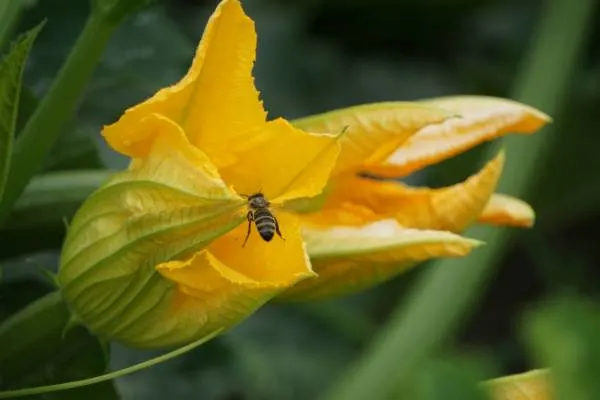
Stage 7: Fruit Development
Once pollination occurs, the ovary of the female flower undergoes a transformation where each individual ovule develops into a singular seed, while the surrounding ovarian wall undergoes a hardening process, ultimately forming the zucchini’s fleshy outer coat.
Zucchini fruits begin to form at the flower’s base.
Initially, the small fruits are pale green and delicate. They develop a darker green color, a firm texture, and lush, glossy skin as they grow.
It is essential to monitor the young plants for any signs of pests or diseases concerning their rapid growth, promptly addressing any issues to ensure healthy fruit development.
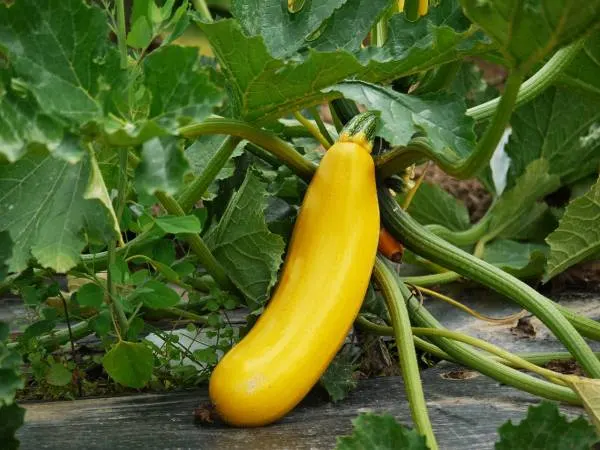
Stage 8: Harvesting Zucchini Plant
Knowing when to harvest summer squash is crucial to enjoying them at their peak flavor and tenderness.
Ripe zucchini plants are typically ready for harvest when they reach six to eight inches in length and have a dark green glossy appearance. This usually happens within a week after pollination has occurred. The total number of days to complete this process is approximately 45–60 days.
When harvesting zucchini first, use a sharp knife or pruner to carefully cut the fruits from the vine, avoiding any damage to the plant. Spear ½ inch stem and let it be attached to the plant.
Regular harvesting promotes continuous fruit production and prevents oversized, tough zucchinis.
Storing Zucchini Post-Harvest!
Storing zucchini properly after harvest period is essential to maintaining its freshness and quality.
Here are some guidelines to follow for storing zucchini:
Cleaning: Before storing, gently wash the zucchini under cool running water to remove any dirt or debris. Pat them dry with a clean towel or allow them to air dry.
Removing Excess Moisture: Excess moisture can cause zucchini to spoil quickly. Make sure the zucchini is completely dry before storing.
Refrigeration: Zucchini is best stored in the refrigerator to prolong its freshness. Place the zucchini in a perforated plastic or vegetable storage bag to allow for proper air circulation.
Temperature and Humidity: Store zucchini in the refrigerator’s vegetable crisper drawer, where the temperature is cooler and more stable. The ideal temperature for zucchini storage is around 40°F (4°C). Maintaining a relative humidity of 85–95% can also help prevent zucchini from drying out.
Shelf Life: Zucchini can typically be stored in the refrigerator for up to 1–2 weeks. However, it is best to consume them as soon as possible for optimal flavor and texture.
Freezing: If you have an abundance of zucchini and want to extend its shelf life further, consider freezing it. Wash, slice, and blanch the zucchini for a few minutes, then cool them quickly in ice water. Drain and pack the zucchini in airtight freezer bags or containers, removing as much air as possible. Label them with the date and store them in the freezer for up to 10–12 months.
Zucchini is best enjoyed fresh, so it’s advisable to use it within a reasonable timeframe after harvesting.
Conclusion!
From seed germination to bountiful harvest, each stage of zucchini growth is a remarkable journey.
By understanding and providing the necessary care at every phase ripe zucchini along, gardeners can enjoy an abundance of fresh, flavorful zucchinis. Remember to monitor for pests, maintain optimal watering, and promote healthy pollination to ensure a successful zucchini harvest.
Proper storage after harvesting the zucchini will help maintain its taste, texture, and nutritional value, allowing you to enjoy delicious zucchini dishes even after the harvest season.
With these insights of the zucchini plant growth stages, you can cultivate thriving zucchini plants and savor the rewards of homegrown produce all summer long.
Regards.
